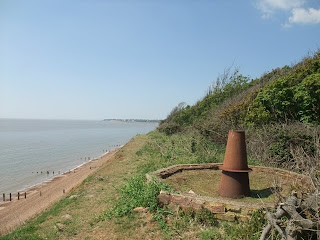Bawdsey Radar site, on the Suffolk Coast, was considered a very likely target for the Germans, either in the event of a full scale invasion or a raid in order to gather information/obtain intelligence. It was thus heavily defended and this post will look at some of the still visible defences at the northern end of the site.
Protection against low level air attacks was provided by a number of light anti-aircraft purpose built emplacements. These were basically a sunken brick pit with a shelter. Still remaining in some of the pits is the socket of the Stork Mount (for twin mounted lewis guns). One emplacement consists of a Hazzard mount for the Oerlikon 20mm gun. Numerous pillboxes defended Bawdsey, including this bullet proof type 24. It has been strengthened to embrasure level with a brick skirt filled with rubble. There can still be found remains of the numerous tank blocks that were built to defend Bawdsey - these four guard an exit from the beach. Wire entanglements would also have formed part of the defences. The remains a triple Dannert Concertina wire obstacle can still be seen, possibly dating from the war. Instead of screw pickets, angle iron pickets have been used. No doubt earthworks would have formed part of the defences - one can still be found along the cliff-top.
I promise only one more post on Bawdsey Radar (some photos of the post war site), plus another post on details of a concrete artillery observation post, previously unrecorded.
Photo 1: Brick built anti-aircraft emplacement
Photo 2: Plan of brick built ant-aircraft emplacement
Photo 3: Socket for stork mount
Photo 4: Hazzard mount for 20 mm gun
Photo 5: Type 24 pillbox
Photo 6: Four standard 5ft cube tank blocks
Photo 7: remains of triple Dannert Concertina fence
Photo 8: Remains of earthwork.








Comments
Post a Comment